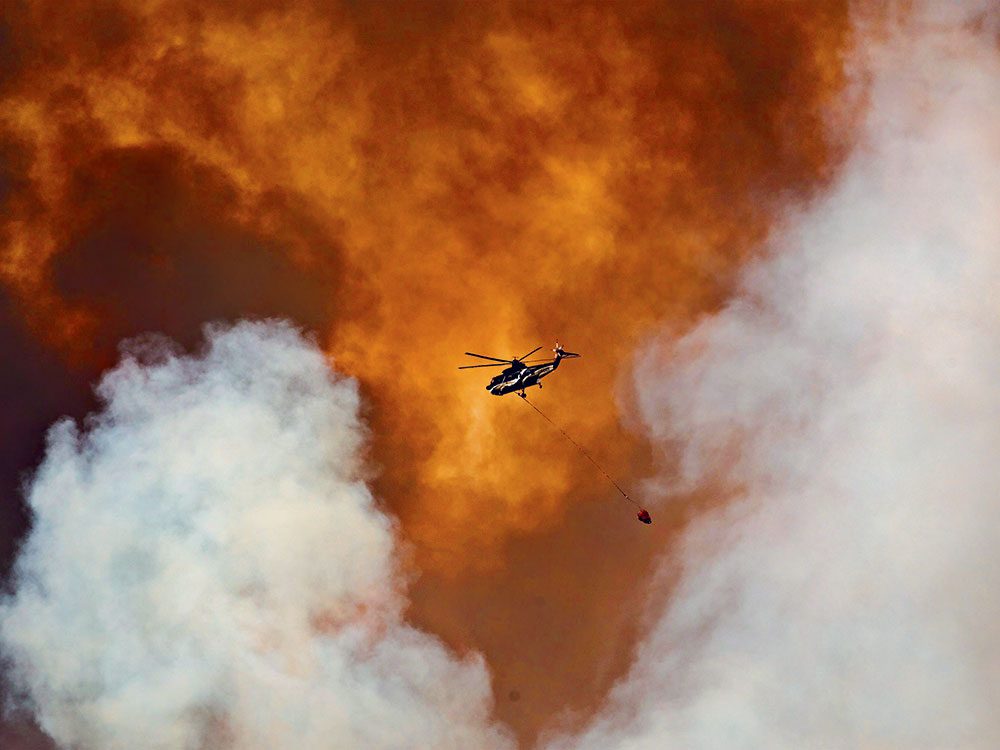
Mission Fort McMurray
It was the middle of the afternoon on May 1, 2016, when patrol choppers swooped in to manage a wildfire in a forested area southwest of Fort McMurray, Alta. But the blaze quickly spread, propelled by gusts of wind, and two months would pass before officials finally deemed the fire “under control.” In that time, flames tore through close to 6,000 square kilometres and displaced more than 88,000 residents. Thanks to the efforts of people across the country, however, there was hope amid the chaos. Here are seven amazing stories.
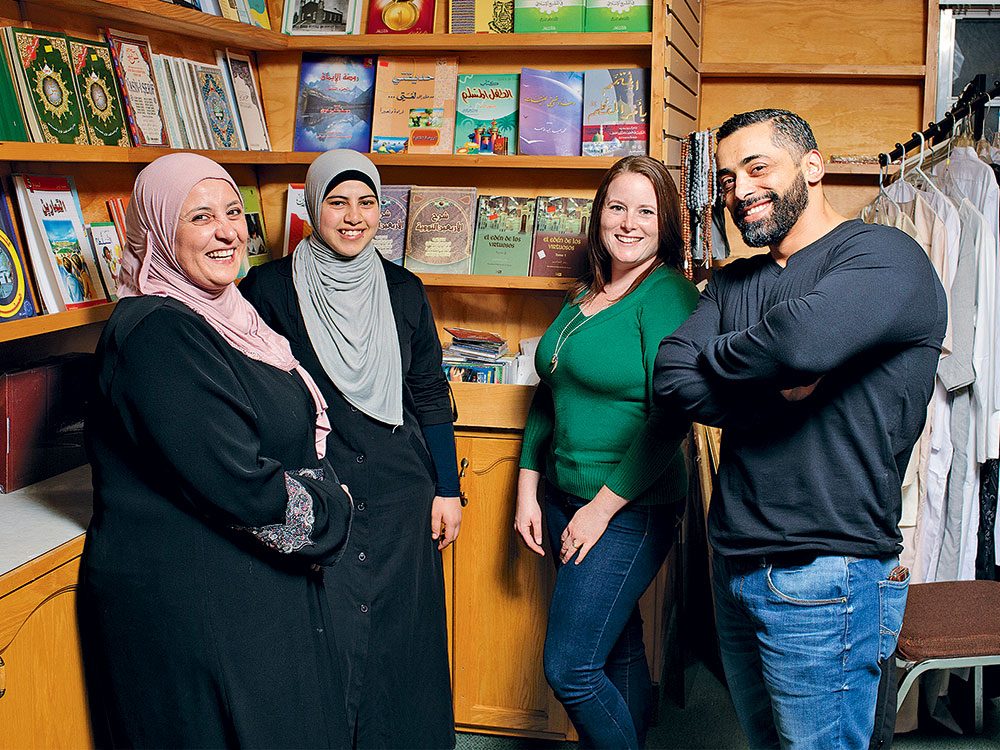
1. Taking Shelter at Al Rashid
By Omar Mouallem
Uzma Afroz will never forget the moment she walked into the mosque. The previous 28 hours had been nightmarish. A teacher’s aide at the Fort McMurray Islamic School, Afroz had been evacuated on a bus with 60 students whose parents were unreachable. Their escape from the wildfires was rerouted multiple times; each attempt was either too dangerous or the intended destination was too overcrowded. They eventually headed to Edmonton, 450 kilometres away, where passengers were reunited with their parents at a conference centre. A driver there was going to Al Rashid, the city’s largest mosque, and offered Afroz a lift. The temple had been converted into a shelter for 200 evacuees, Muslims and non-Muslim alike, with meals to feed hundreds more drop-in visitors.
After the ember-filled skies and crying children, the mosque was a balm: kids played while women chatted. The scent of hot food from Afroz’s native Pakistan supplanted the smell of smoke in her nostrils. “It didn’t look like people coming from a disaster,” recalls Afroz, who’s lived in Canada since 2011. “It felt like home.”
This speedy transformation—from temple to shelter, donation centre and kitchen in less than a day—was possible because the Muslim community was prepared. Five months earlier, the Edmonton Islamic Relief Centre (EIRC) had organized a campaign to assist thousands of Syrians.
In Sept. 2015, Edmonton high-school teacher Hussein Jomaa heard that Canada would be welcoming up to 25,000 refugees by the end of the year. Having emigrated from Lebanon in 2006, he knew Canadian winters could be a shock to people who are used to more temperate climates, so he started collecting coats. Word spread, donations ballooned, and soon Al Rashid Mosque offered him the use of a vacant building. Within a couple of months, the EIRC was born and had amassed enough clothing for 20,000 people—and more. “We had everything from toothpicks to furniture,” says Jomaa.
The centre also had the infrastructure to handle a significant relief effort: moving trucks, a help hotline, $250,000 and lots of muscle. EIRC’s 2,000 volunteers roughly matched the number of refugees who’d just arrived in Edmonton. When the wildfires displaced 88,000 Albertans, the hotline was ringing again.
By midnight on May 3, Al Rashid had welcome a dozen evacuees. There were just enough supplies for the first wave, who were given prayer carpets and bedding to sleep on, but a shipment of cots sponsored by Islamic Relief of Canada arrived in the night, as well as another 50 people.
“We realized we had to do more than just open our doors,” says Salwa Kadri, the mosque’s office and program manager. She’s been a congregant of the 78-year-old mosque for four decades. Back when she joined, Islam was rarely discussed in Canada, let alone cast in a negative light. Sensing discomfort from some of the non-Muslim evacuees, she and Jomaa welcomed them and outlined the mosque activities that might be startling, like the 4 a.m. call to prayer.
Everything but funerals and and prayers was put on hold to accommodate the Fort McMurray contingent. The mosque offered up its imam’s residence, and worshippers and neighbours invited strangers to stay in spare rooms and basement suites.
“It was heartening to be able to work together toward the same goal,” says Danielle McDougall, a resident of Lauderdale, the North Edmonton neighbourhood in which Al Rashid is located. McDougall had been volunteering at a relief centre nearby, and once donations there started to overflow, she offered them to Kadri.
Lemis Aldarwish, a 21-year-old student, was one of the 110 volunteers at Al Rashid. She had arrived in Edmonton in 2015, two years after fleeing her farming village in Syria with her family. “The evacuees would tell me the story of how they left their homes, and I knew exactly how that feels,” she says. For a week in May, Aldarwish returned to the mosque every day to cook, sort donations and sit with Syrian refugees. “I was very happy to see people from different religions and countries collaborating, just being human.”
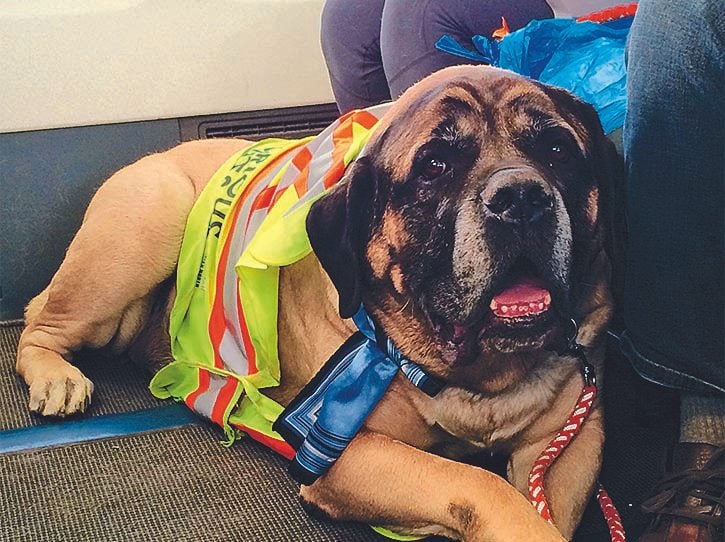
2. Operation Animal Rescue
By Megan Jones
Not all of Fort McMurray’s evacuees were two-legged. At certain airlines, pet-loving officials pledged to shuttle critters out of the danger zone. Given the high number of animals that needed transport, cats, dogs, turtles, hedgehogs and even a snake were permitted to ride alongside their humans in the cabin. Kerri Power, who was flown south to Calgary with her two chihuahuas, says the trip wasn’t as wild as one might expect: “All of the pets were so well-behaved.”
Meanwhile, livestock were evacuated in trailers or cut loose. When Nadia Crewe, a resident of Andrew, Alta., saw a news report about Fort McMurray, she knew how to help. The 32-year-old opened up her 17-acre property to 12 horses, three cats, four dogs and a turtle—and 21 humans. “I wanted to provide everyone with a familiar environment,” she says.
Two of the 12 horses belonged to Crewe’s pal Megan Bastien, who had been forced to leave three others behind. She had inherited the abandoned steeds from her father, who had recently passed away, and she was determined to get them back.
Three days after the evacuation, Bastien and Crewe returned to Fort McMurray, where an officer arranged for a police escort. The trees on Bastien’s property were burning when they arrived, but her father’s trio was miraculously unharmed.
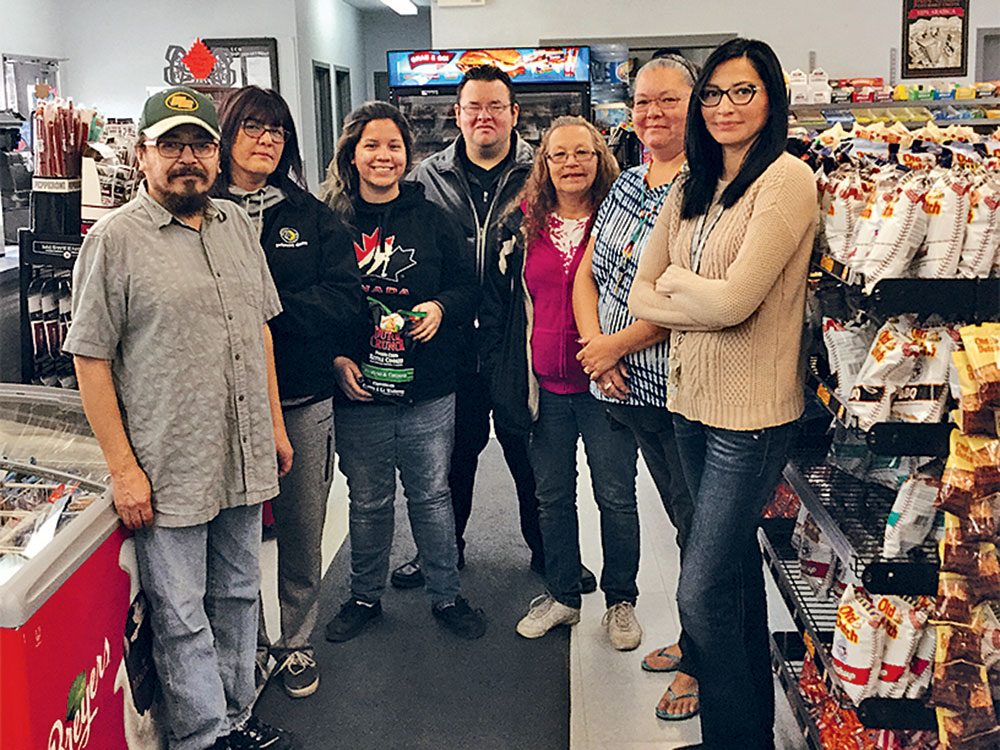
3. Fuel from the Fire
By Vibhu Gairola
By the evening of Tuesday, May 3, the mandatory-evacuation order extended to all Fort McMurray residents, and the roads out of town were jammed with traffic. Within 36 hours, exhausted drivers fleeing south on Highway 60 were being offered a welcome gift at the North on 60 Gas Bar and Convenience Store, managed by Valerie A.: a tank of gas, compliments of the Enoch Cree Nation.
“There are a fair amount of First Nations folks in the Fort Mac area, but everybody needed help,” says Valerie. “On Thursday morning, I sent Chief Billy Morin a Facebook message asking if I could offer a free fill of gas at the store. He liked the idea and agreed that we should extend the donations until the end of the weekend. We gave out around $8,000 worth of gas; I can’t even tell you how many tanks. I remember one customer coming up and asking if she could hug me. It was so heartwarming.”
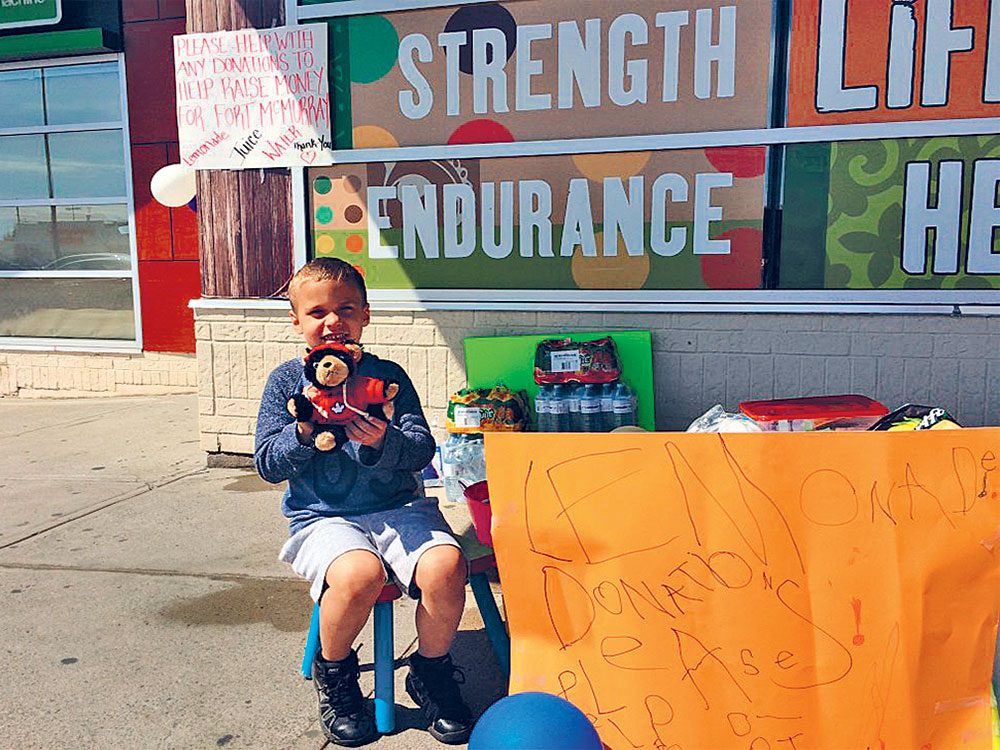
4. Stand and Deliver
By Katie Hewitt
As fundraising efforts kicked off across the country, Canadian kids proved you don’t have to be a grown-up to make a difference. Car washes, bake sales and lemonade stands seemed to be everywhere, but no stand was as poplar as the one run by five-year-old Alexander Tuck in Whitby, Ont. After setting up shop for a single Saturday outside the Thickston shopping plaza, he raised over $2,600 for the Red Cross—with help from his mom, Danielle.
“Alexander was quite upset about the fire, about kids losing their toys,” says Tuck. “I was overwhelmed by how many generous people came out to a little boy’s lemonade stand. A few families from Fort McMurray happened to be in town visiting. One woman we met had lost her home. She brought Alexander a teddy bear. There were a lot of tears.”

5. Precious Connections
By Sarah Liss
When Quinn Lotsberg left for work on May 3, he didn’t know his house was about to be reduced to cinders. A high-school vice-principal, Lotsberg also collects gemstones and precious metals. Once he was permitted to return to his property in mid-June, he donned a hazmat suit, grabbed a prospector’s pan and began sifting through the wreckage for his modest but much-loved stash. As he searched, word spread through the gemstone community, and Hans Durstling, a venerated gem cutter in Moncton, volunteered to restore any stones Lotsberg found, free of charge.
“Quinn sent me a handful of ash with six or seven stones in it,” says Durstling. “Rubies, sapphires, peridots, topazes, garnets and tourmalines that looked like they’d been buried in kitty litter, rained on for a month and then baked in the oven at high neat.”
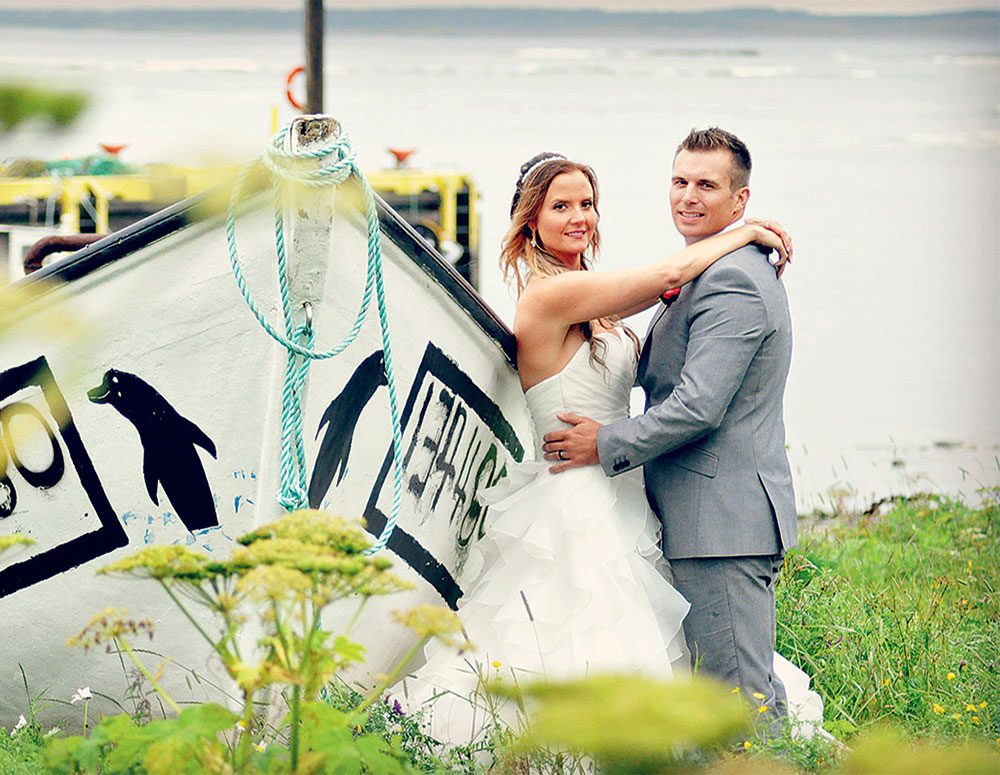
6. Saving the Date
By Katie Hewitt
Bride-to-be Judy Dredge heard the call to evacuate while she was at her job as a bus driver for Sparksman Transportation. She frantically texted a list of must-save wedding items to her fiance, Paul, whom she was due to marry on August 6. He was able to rescue the dress and the rings, but nothing else.
A month later, Dredge asked for help on social media, and hundreds of people, mostly strangers, came forward with offers of a veil and headpiece, bouquets and chair covers, among other things. In early August, as planned, the couple was joined in a ceremony in Black Duck Cove, N.L.—where Paul’s 96-year-old grandmother is based—in front of 200 guests. “The wedding was everything I had dreamed of. It meant even more after experiencing the loss of our home,” says Dredge.
At their reception, the happy couple raised $500 for Fort McMurray’s first responders.
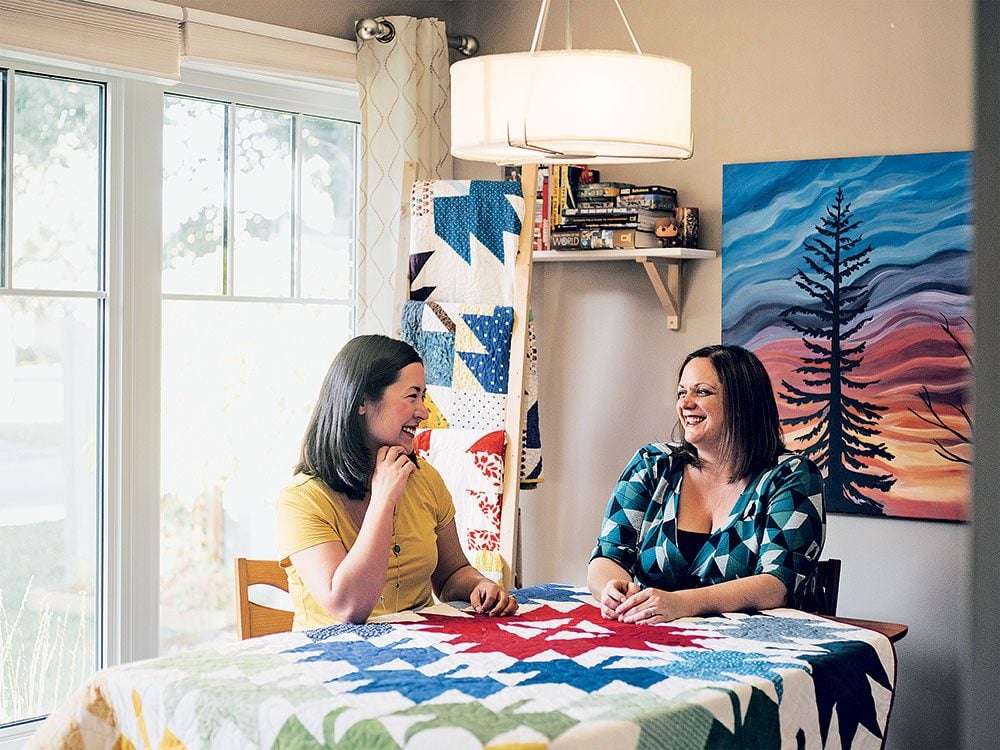
7. The Blanket Effect
By Chris Lackner
If a quilt is a handmade hug, Fort McMurray residents are feeling the love from around the world. When Stacey O’Malley put out a call online for quilt blocks featuring a maple leaf design in white, blue, red, green and gold – the colours of Alberta’s flag – she was looking to comfort those who had lost their homes. The 33-year-old had moved to Ottawa from Edmonton in 2015 and knows many people with loved ones in Fort McMurray.
O’Malley had hoped to amass 100 blocks from contributors—enough material to make 10 quilts—but nearly 2,000 arrived from across Canada and the United States, as well as England, Japan, Scotland and Australia. Within a month, she had enlisted the help of the Ottawa Modern Quilt Guild, a social quilting group, and by the end of October, the Ottawans had sent 70 quilts to the western province.
Creating a single quilt made up of 24 to 42 blocks can take 15 to 30 hours, depending on the design. The majority of the work involved in making the 70 covers was done over two days in July and August, when roughly 40 guild members and 30 other volunteers participated in sew-ins. “There was lots of talking, laughing and snacking,” says 35-year-old Amber Mitchener, the president of Ottawa Modern.
The group used almost all of the donated blocks, even when benefactors got creative with the guidelines and sent in maple leaves sewn from cloth patterned with Scottie dogs and kilted girls. Reaching out to businesses at home and abroad—donors included Cotton Mill Threadworks in Dundas, Ont., and an Italian thread manufacturer named Aurifil—further sustained the drive.
Ottawa Modern shipped its completed creations to the United Way, one of the main distributors on the ground in Alberta, along with the Salvation Army. By the beginning of October, says Russell Thomas, director of communications and community impact for the United Way of Fort McMurray, more than 330 quilts had already been handed out—just in time for the reliable early western winter.
The first batch went to staffers of non-profit organizations who’d lost their homes in the blaze, as well as firefighters and other first responders, but the Facebook group Quilts for Fort McMurray is lobbying for each of the area’s 88,000 evacuees to be gifted a cover. Local guilds, like the one in Ottawa, are the key to meeting that ambitious goal.
“Modern quilters place emphasis on the utility aspect of quilting,” says O’Malley. “We want them to be used, cuddled, loved, washed and reused—not saved as an heirloom.”